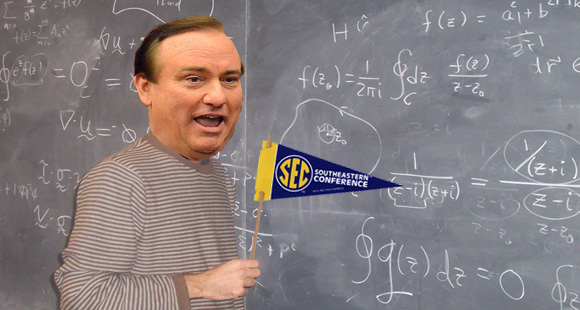
One of the things that I'm going to have to own up to when I die and am held accountable for my sins, by whatever angel, three headed dog, personification of the moon, or avatar of death keeps that tally, is the very large amount of time I've spent watching ESPN.
And not just for sports recap purposes. No, I have literally sat down and said "Huh, I wonder what JJ Adande has to say about the topic du jour!" and "Ooo that darn Skip Bayless, I'm sure he'll say something I disagree with so much that I'll watch a full hour of him smugly BSing his way through another specious argument!"
I'm better now, sort of. I started writing for 11W almost exactly three years ago, so in that time I've started to recognize the difference between signal and noise when it comes to sports reporting. And to be fair, I've also learned that bad sports opining is by no means limited to ESPN (see: everything Mike Bianchi has written in the last month).
I still watch way too much of the World Wide Leader for my own good and give more time of day to the Bianchis of the world than they even remotely deserve, but at least now I recognize them for what they are. And, as an added bonus, it's given me insight into how those hamster wheels in their brains work.
So the theme of today is pundit math. Three months ago I commissioned a team of mathmagicians to aid me in quantifying various mental leaps that lazy sports pundits make on a regular basis.
In other words, you can now know what Stephen A. Smith means when he talks about "clutchness." Finally, using a hard, unforgiving, EXTREMELY ACCURATE mathematical process, we can see into the mind of a Colin Cowherd with startling clarity as he rambles about "grit." And we'll also find out just where their hatred of blogging comes from. It may not make sense to us, the layman, but I believe that despite all that I find wrong with it, there has to be some kind of underlying method to this madness.
Here are our results.
Basketball
"Clutchness"

Contrary to popular belief, there is no "clutch gene." Scientists who have mapped the human genome agree that while there is definitely a gene for willingness to do lawnwork and an ability to get your taxes done in March, apparently being clutch is left to the realm of pure mathematics, and it is from this field that Stephen A. Smith, Skip Bayless, Mike & Mike, and Colin Cowherd draw their analysis. A breakdown:
- volGJV: A measure of the approximate volume of Gus Johnson's voice in the last two minutes of any given game.
- klIns: Killer instinct, which as we all know is measured in MegaKobes and TetraJordans.
- DaMan: Desire to be "the man." Not applicable to women's athletics because in a pundit's world they only exist to be made fun of.
- sKiPA and sKiPB: Actual games watched by Skip Bayless minus times berated on air by Skip Bayless. Usually a very low negative number.
- MADNESS: General proximity to March Madness. NBA playoffs can be substituted here, but either way it should be noted that you can only be "clutch" if there's an event worthy of making a three minute segment about on Sportscenter.
Football
"Grit"

The ultimate football stat. Yes, yards after catch, or quarterback efficiency, or even plain ol' turnovers versus takeaways can be somewhat useful in determining the overall abilities of a player or team. But as ESPN and other outlets have made readily apparent to us time and time again, the real measure of a football player is their grittiness; do they "look" like a football player? Would my mom be proud to have them date her daughter? Can you picture them stoically suffering through black lung while working in a Pennsylvania coal mine as easily as you can imagine them rushing for a two point conversion? If yes, then they have grit. Here's how we measure that.
- bgL: Boyish good looks, which lets everyone know that the athlete "plays the game the right way" and "treats his coach with respect."
- OWP: Closely related to the above, this a measure of the player's popularity with old white people. A lack of curse words and frequent mentions of Lawrence Welk help this.
- DUI: Number of DUIs covered up by local law enforcement.
- JSF: The Jeremy Schaap Factor, or number of minutes devoted to an athlete on College Gameday to tell their heroic story of somehow not being a huge douchebag.
- Tim Tebow's Adorable Face: You know why it's there.
- heart: Chances that an athlete would be selected as one of Captain Planet's Planeteers.
- INTS: Intensity. Yelling helps this number go up (which is good), but keep in mind it's only positive when deemed appropriate by television analysts who have little to no context whatsoever. Generally, however, if you're a good quarterback you are probably exhorting your teammates to greater heights. If you're mediocre or worse, you're clearly just being an asshole.
BLOGGING
"Dismissiveness"

Bloggers are dumb. I mean, it's right here in the math, and guys with millions of fans and followers on Facebook and Twitter wouldn't hold a weird, longstanding grudge against people like me (who write part time and for free) without good reasoning on solid mathematical ground, right? Here's how their outrage is born.
- DD: Mad Men references misunderstood as thinly veiled threats. This can be substituted for Adventure Time, Parks and Rec, or any other bit of pop culture not known by the pundit.
- E: Actual effort put into their jobs as a commentator of sports. Usually somewhat higher than expected, but not nearly as high as predicted by the pundits themselves.
- MOM: Likelihood that a particular blogger lives in his or her mother's basement. Approaches 100%.
- Skull and crossbones: Internalized anxiety about the death of traditional media.
- money+ and money-: Yearly salary and yearly salary actually earned.
- 550: Number representing the average amount of words written per week. Usually entirely in one line paragraphs so as to convey a sense of the dramatic.
- ATH: Number of points granted to pundit by Tony Reali on Around The Horn.
Maybe you're looking at these formulae and going "Uhhh this looks like total crap. None of this actually adds up, and it looks like you just slapped a bunch of math symbols together." Which I resent greatly. No, if this were all just a bunch of BS, that would mean that there really isn't a rhyme or reason to what most popular sports pundits say or type to a large audience.
It would mean that instead of an honest, quantitative analysis of a person or event, they just go off whatever stupid narrative they've decided to construct for themselves. It would mean that ESPN and a litany of other sports outlets are paying people hundreds of thousands, sometimes MILLIONS of dollars to spew indecipherable crap on a regular basis.
I refuse to believe that despite whatever problems I may have with their content, that these people aren't making at least an honest effort to analyze the sports that we all love. Because if they weren't, that would be sad and infuriating.

